Read our Messina 1347 board game review to find out about its superb theme implementation and game arch. But does the initial enthusiasm vane after more plays?
Introduction to Messina 1347 – Board Game Review
As harsh as the current pandemic seems to all of us, it’s by no means the first or the worst in history. You’ve all heard of the Black Death, the plague that came to Europe in the 14th Century and devastated it several times.
But a less know fact is how it arrived. It happened in Messina when in 1347 a ship from Crimea arrived with infected sailors on board.
And here’s where our game comes in. The city is getting engulfed in the plague, while you manage a noble family on the outskirts of the city, trying to save the citizens and fight the disease with fire. As the illness begins to recede, you will plan to repopulate the city with surviving citizens.
Messina 1347 Facts
Published: 2021
Designers: Raúl Fernández Aparicio and Vladimír Suchý
Artists: Michal Peichl
Genre: worker placement
Playing time: 45-90 minutes
Players: 1-4, plays well with all player numbers
Complexity: medium
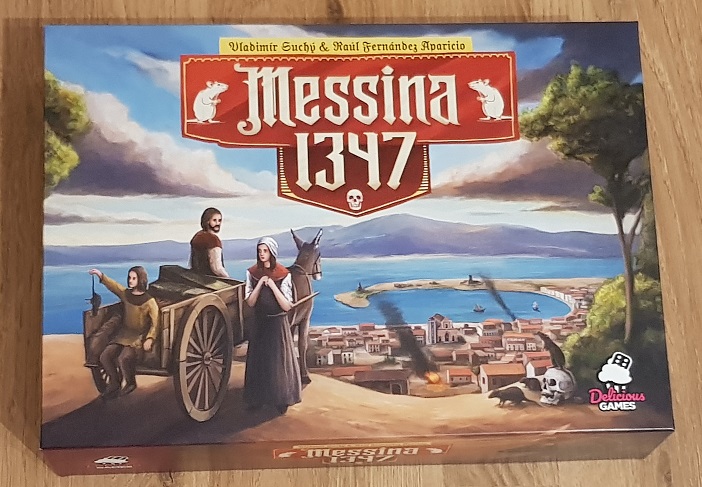
Theme
While I don’t know if the theme choice is deliberate or coincidental, I can tell you that it’s definitely a brave choice. I know, we fought the diseases many times in the Pandemic series, but here in Messina, it’s different. It’s based on real historic events, which makes it much more tangible.
Moreover, the theme implementation into game mechanics is superb. The plague arrives by ships, spreads through the city, and your lieutenants travel the city, saving citizens, and scavenging for resources.
A healthy citizen can go to work on your estate immediately, while an infected citizen must go to the quarantine for two rounds. Citizens you don’t save are removed at the end of the round – dead. With the lack of better methods, fighting the disease is done simply with fire, while the penalty for not doing that are lovely rat tokens.
The plague worsens round by round, while finally – in round 6 – it starts to recede and the city can breathe again. Now is the time to move your healthy citizens back to their homes.
While still predominantly a strategy (euro) game, Messina 1347 does an excellent job at immersing you. I love how Delicious Games are becoming the masters of theme implementation. While it felt pasted-on in Underwater Cities, Praga Caput Regni and Messina 1347 are excellent examples of how to build a strategy game around the theme.
Presentation
Messina is a visually appealing game. I particularly like the artwork – houses on the hexes, wagons, ships, quarantine cabins, and the cover.
But when you assemble the hexes into a map and add citizens, plague tokens, and workers to them, it begins to look slightly cluttered. I understand that they tried to strike a balance between art and functionality and they did fine in the end. But it wouldn’t hurt if they have erred slightly more towards functionality.
The components are solid and pretty standard. There’s no fancy stuff, but the combination of wood and cardboard creates a classic tactile board game experience that we all like. The end impression is good and the price is reasonable, as well.
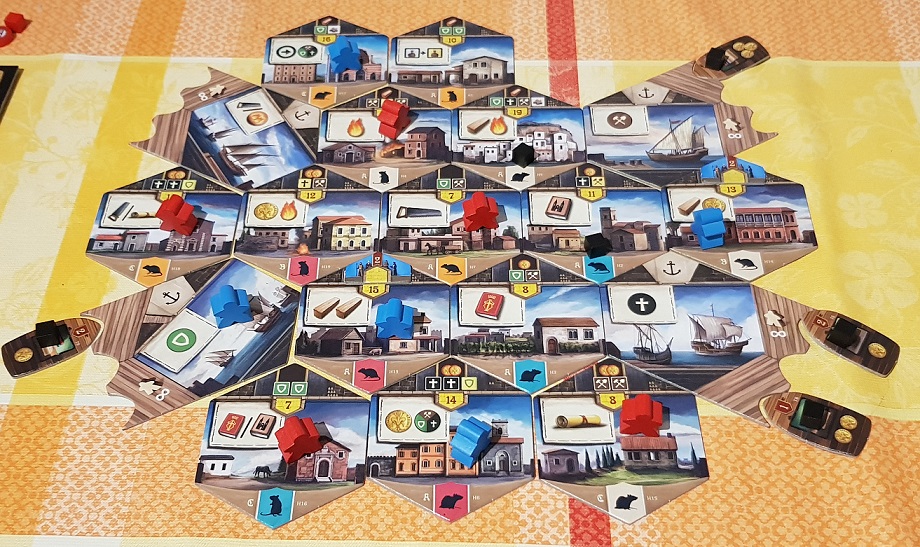
Rulebook and Learning
For the most part, the rulebook is good and I did not have any trouble learning the game. I only had to read through it once and understood the game principles solidly. Granted, the gameplay is fairly straightforward and easy to remember. Especially with player aids sheets included.
There are a few rules that are not fully explained or are ambiguous, particularly about solo mode (bot tiles reshuffling and scoring) or register advancement (can you “advance” beyond the track?).
The graphical design of the rulebook is lovely and with the quality of the paper used, it’s a joy to hold in your hands. Overall, a reliable rulebook, with a few minor issues.
Overview of the Game – How Messina 1347 is Played
Messina is a worker-placement game with elements of engine building, track movement, and grid movement.
The game starts on a randomly built map of Messina, its size depends on player count. Then, the districts are semi-randomly (with a help of a population wheel) infected and populated with three types of citizens: nuns, workers, and nobles.
On your turn, you will move one of your workers onto a hex, saving citizens, fighting the plague, and carrying out a hex-specific action. When you run out of workers (you start with three and can increase this number to five), the round ends, the city gets infected and repopulated, and another round begins, with a total of six rounds.
Actions on the hex range from obtaining basic resources (coins, wood, and fire), to activating overseers, progressing on tracks, constructing buildings and wagons, progressing scrolls, and so on.
Working on the estate sounds better than dying from the plague
Saved citizens go to your estate – either in quarantine or directly to work. With certain actions, you’ll be able to move your overseers and activate the citizens on your estate, making them perform similar actions as above. The further down its path the overseer gets, the more citizens he can activate.
The engine building aspect shows itself in constructing quarantine buildings, workshops, and upgrading citizens. Now, with every production and activation, you’ll get more resources – or points directly.
There are three tracks to progress, and all have various goodies you can collect on the way. Free resources, free actions, extra workers, overseer upgrades and activations, and also victory points. Certain actions also allow you to advance your scrolls – these act as special scoring conditions, relevant to your playing style. I.e. if you built 4 workshops, you might want to advance the scroll which will net you more points for them.
The plague starts receding for the last round, which means that in the last couple of rounds, you’ll be using your wagons to repopulate the Messina hexes. This gives you a lot of victory points, but you have to meet the hex’s demands in population and resources.
After the sixth round, the points are added up and the winner is declared.
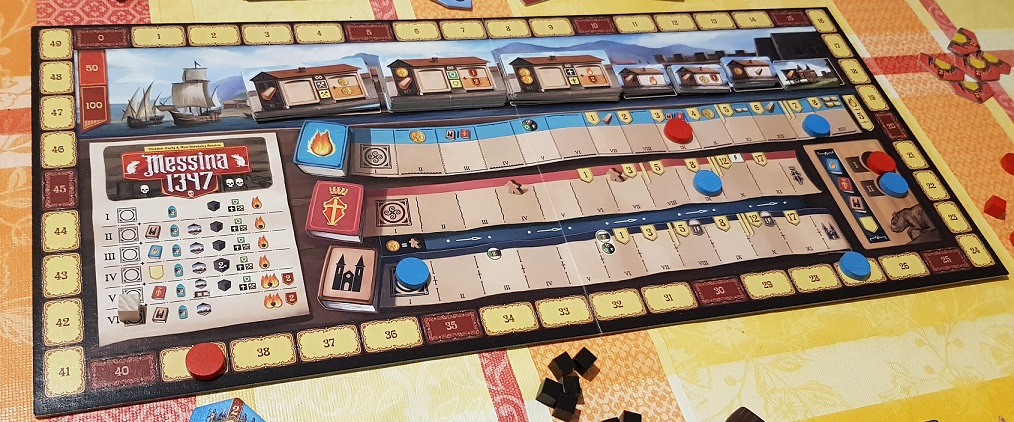
Pleasing Gameplay Arch
One of my favorite things about Messina 1347 is its gameplay arch. It starts slowly – the city gets infected and since the resources are scarce, you can barely do much about it. Once you filled your estate with citizens and constructed some buildings, you get more and more effective at dealing with the plague.
But the game has a counterattack. For the last two rounds, fighting the plague gets more expensive, making you choose your targets carefully once more.
Then there’s the repopulation twist. There are no more infections in the last round, so typically from round five, you’ll start repopulating the neighborhoods. This changes the pace of the game once more, making Messina a rollercoaster of a board game.
Choices, Choices …
Every turn, Messina will present many choices to players. Where will you move workers? You can stay in your hex or move one hex for free, with further movement costs coins. Not only is it important what action you want to do this turn, but also where you’ll end up. Taking a ship might be lucrative, but harbors are remote and it will cost money to get there (and back).
How you’ll develop your estate is another matter. You probably won’t be able to complete a full movement with more than one overseer, so you want to place all the citizens around his path. Then at activating, you can only activate a limited number of them and you must make a decision again.
It’s a similar story with quarantine cabins and workshops. There are various types available and they produce different resources. Again, the choice is yours.
This is a good approach to gaming – it keeps the players engaged and their choices matter to the outcome. But, on the other hand, the plethora of possibilities means that it’s very hard to figure out an optimal strategy.
Often, you’ll have to make decisions based on your gut, rather than a carefully thought-out process. On one hand, this caters to casual players by helping to keep the analysis paralysis somewhat low (because it’s just too much to take everything into account), but on the other hand, it will make the hardcore players frustrated, because they won’t be able to figure the game out.
Cool Combos
In compliance with choices come the numerous combos, that each action possibly activates. If you remove a plague cube, you will advance on a popularity track, which can activate an overseer, or make you advance on the other two tracks, which can activate further actions, and so on. You know the drill.
This mechanism is highly enjoyable since it gives you a sense of accomplishment and a feeling that you outsmarted the game. Yet it remains on a level where you can still manage everything without too much of a headache.
In other words, combo-chaining is fun, but it never gets out of hand. It’s not like in Praga Caput Regni where you activate so many bonuses at once, that you can easily lose track.
Scalability and Playing time
Messina works well with all player counts from 1 to 4. The map and the central board scale accordingly, the turns are usually short and there’s not much downtime. The longest game-stopper is actually the phase where you have to infect and repopulate the city.
This phase is quite fiddly and time-consuming. But if there are more players, they can divide the labor among them. You place the nuns, you place the plague cubes, I’ll place the workers and nobles.
Player interaction is what you expect from a worker placement game. You compete for action slots and also for available buildings. Outside this, it’s every player (and his board) alone.
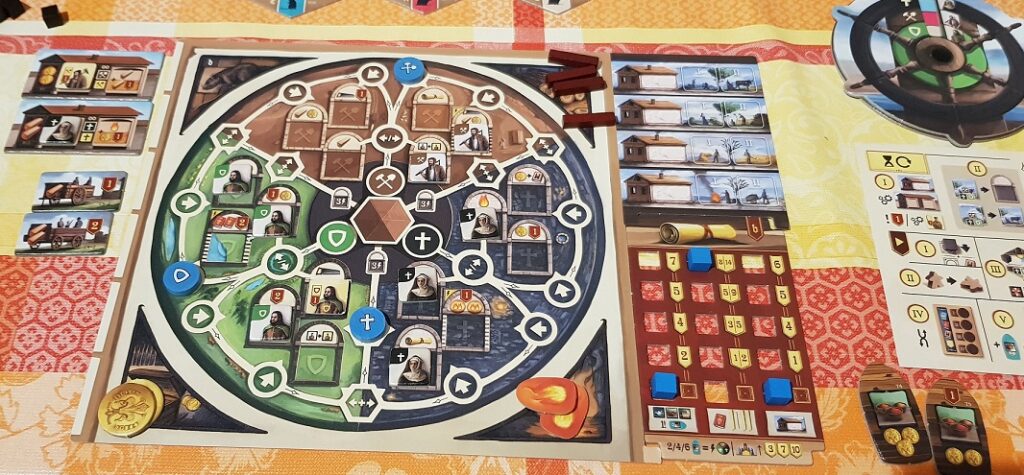
Fast-Flowing Solo Mode
The solo mode is also fairly good. Yes, the infect phase is painfully time-consuming and it stops the game flow. But with some practice, you can get through it without losing too much time.
Automa is there just to block hexes from you and you play against a high score. It works smoothly, but it doesn’t really simulate a human player. Here, any hex has the same chance of being occupied and you can’t make educated guesses on where they will go next.
There is some ambiguity in the rulebook regarding how you should re-shuffle the automa tiles (every round) and how the neighborhoods are scored (normally + bonus score depending on how many you have). These are not unimportant aspects and should definitely be clearly stated in the rulebook, without players having to resort to BGG forums for answers.
It’s worth noting that the target score for the solo mode is set rather high (130, while I still struggle to break 100 after half a dozen solo plays) and it would be nice to have more levels of attainable goals. Just so you don’t feel like a complete failure after every game. 🙂
Debatable Long-Term Appeal
Messina is a polished and very enjoyable game. However, I feel like its long-term appeal is questionable. Yes, the setup offers plenty of variability. The city hexes are set up randomly, the boats, plague, and citizens come in randomly, and so on. There are even advanced asymmetrical player boards with custom scrolls, which further add to the variety.
But it’s to no avail. I’ve played over 10 games and tried various playstyles (quarantine cabin heavy, no quarantine cabins, strong wood production, focused on different tracks, focused on ships, took no ships) in combination with different starting boards and scroll boards (I’ve tried to go synergetic and non-synergetic with those).
Unfortunately, all those games felt the same to me. Even if I decided to go for different goals, I ended up doing the same moves, finished with a similar score, and the game played roughly the same. I guess Messina is just one of those games that are great for occasional play, but you quickly see everything there is in it.
Part of it is definitely down to the aforementioned issue of how hard it is to figure out an optimal strategy. But it’s also down to the lack of objectives. I thought the asymmetric scroll boards from the advanced variants would fix this. They do to an extent, but it’s not enough.
I think the game would really benefit from a couple of concrete objective cards for each game. I.e. be the first to own 4 workshops, accumulate 10 coins, and so on. Incidentally, this is not the first game from Delicious Games that suffers from this issue. Praga Caput Regni could also use more solid objectives.
This lack of replayability also kills the solo mode for me. In a solo game, I want to be challenged, try different approaches, and have a memorable, unique experience every time I sit down.
Conclusion
Don’t get me wrong, Messina is far from a bad game. It has a great thematic arch, its game mechanics are solid, and the gameplay is smooth.
But it completely depends on what kind of a player you are. If you normally play a board game less than half a dozen times, you will have a blast. With the price of the game, you’ll get your money’s worth easily and the game doesn’t have a steep learning curve.
On the other hand, if you are a player that wants to have a deep, challenging experience, that you’ll go back again and again to explore its intricacies, you will be disappointed after a few fun games.
Unfortunately, Messina 1347 won’t make it to the lists of all-time great board games. It remains labeled as merely … good.
Read more:
Do you like what you just read? Consider subscribing for more content:
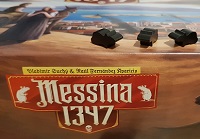

Excellent as ever, thanks.
Thanks for the kind words. 🙂